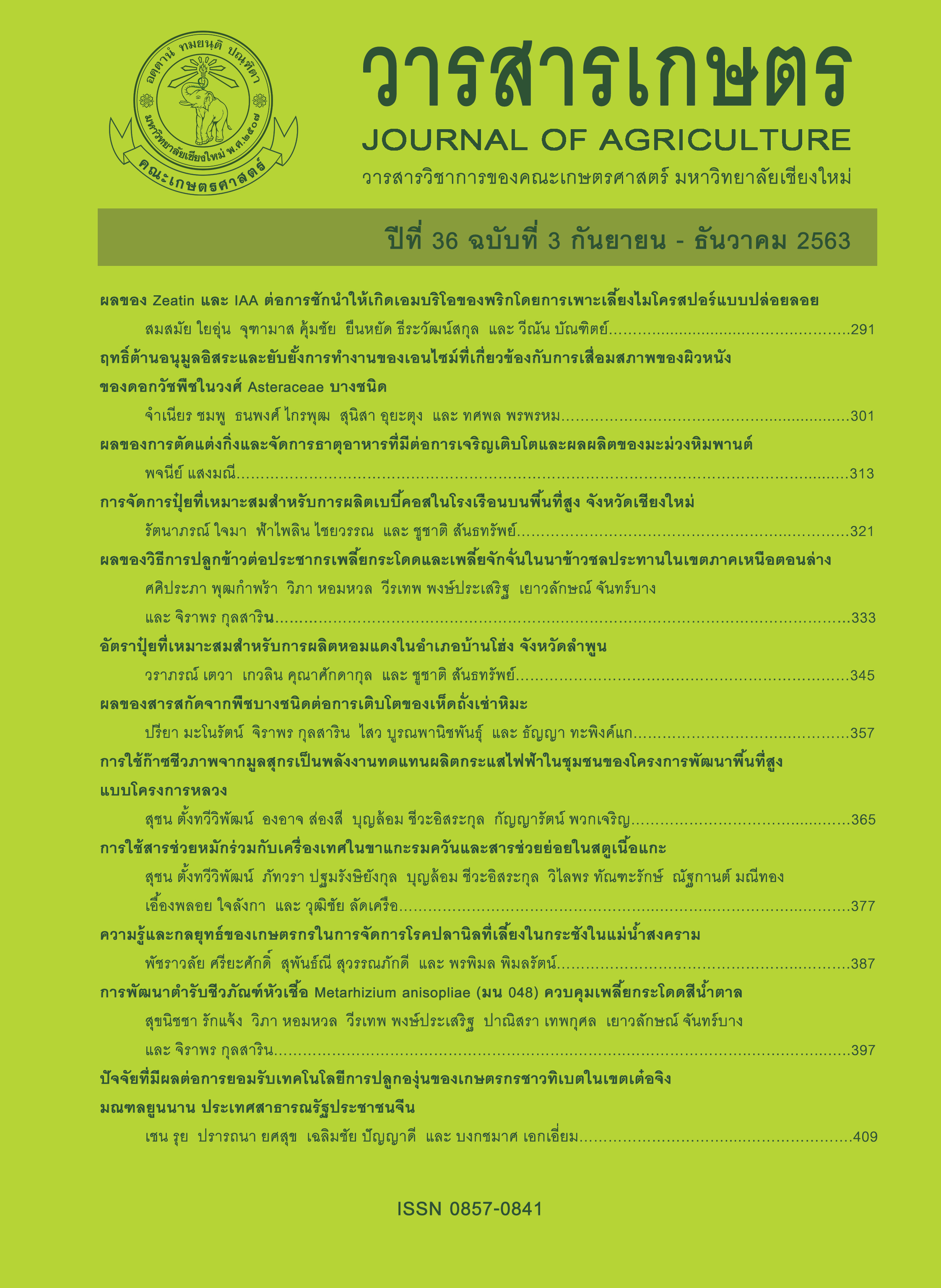ปัจจัยที่มีผลต่อการยอมรับเทคโนโลยีการปลูกองุ่นของเกษตรกรชาวทิเบต ในเขตเต๋อจิง มณฑลยูนนาน ประเทศสาธารณรัฐประชาชนจีน
Main Article Content
บทคัดย่อ
ประเทศจีนมีประวัติการปลูกองุ่นมาเป็นเวลานาน และพื้นที่ปลูกองุ่นในประเทศมีเพิ่มขึ้นอย่างมากในระยะเวลาสองสามปีที่ผ่านมา เขตเต๋อจิง ในมณฑลยูนนานเป็นพื้นที่ใหม่ที่ได้รับการพัฒนาให้เป็นพื้นที่ปลูกองุ่นเนื่องด้วยสภาพทางธรรมชาติที่เหมาะสมและวัฒนธรรมของชนเผ่าจีนทิเบตที่โดดเด่น เพื่อให้มีการผลิตที่สอดคล้องกับนโยบายการพัฒนาการเกษตรในพื้นที่ จึงมีความสำคัญที่จะศึกษาการยอมรับและปัจจัยที่มีผลต่อการยอมรับเทคโนโลยีการปลูกองุ่นของผู้ปลูกองุ่นในพื้นที่เต๋อจิง ประชากรเป้าหมายในการศึกษาคือ เกษตรกรผู้ปลูกองุ่นชาวจีนทิเบตในเขตเต๋อจิง จำนวน 2,200 คน กำหนดขนาดกลุ่มตัวอย่างจำนวน 338 คน สุ่มตัวอย่างโดยเทคนิคการสุ่มอย่างง่าย เครื่องมือในการเก็บรวบรวมข้อมูลเป็นแบบสอบถามซึ่งผ่านการตรวจสอบค่าความเชื่อถือได้ของเครื่องมือ (มีค่า Cronbach’s alpha เท่ากับ 0.938) วิเคราะห์ข้อมูลด้วยโปรแกรมสำเร็จรูปเพื่อการวิเคราะห์ข้อมูลทางสังคมศาสตร์ ผลการศึกษาพบว่า เกษตรกรมีการยอมรับในระดับมาก ในด้านการเลือกพื้นที่และดินที่ปลูก เทคนิคการปลูก วิธีการสร้างชั้นสำหรับองุ่น การจัดการองุ่นในฤดูใบไม้ผลิ การให้ปุ๋ย การให้น้ำ และการเก็บเกี่ยว และพบว่า อายุ ประสบการณ์นอกพื้นที่ รายได้ของครัวเรือน สัดส่วนของรายได้จากการผลิตองุ่น การศึกษา จำนวนแรงงานในครัวเรือน และระดับความพึงพอใจต่อการให้บริการของเจ้าหน้าที่ส่งเสริมการเกษตร มีความสัมพันธ์อย่างมีนัยสำคัญทางสถิติที่ระดับ 0.05 กับการยอมรับเทคโนโลยีฯ ของเกษตรกร
Article Details
เอกสารอ้างอิง
Ajewole, O.C. 2010. Farmer’s response to adoption of commercially available organic fertilizers in Oyo State, Nigeria. African Journal of Agricultural Research 5(18): 2497-2503.
Alexander, C.E. and T. Van Mellor. 2005. Determinants of corn rootworm resistant corn adoption in Indiana. AgBioForum 8(4): 197-204.
Deqin county. 2015. Deqin county Government Operational Report. Shangri-La. 223 p (in Chinese)
Feder, G., R.E. Just and D. Zilberman. 1985. Adoption of agricultural innovations in developing countries: A survey. Economic Development and Cultural Change 33(2): 255-298.
Foster, A.D. and M.R. Rosenzweig. 1995. Learning by doing and learning from others: Human capital and technical change in agriculture. Journal of Political Economy 103(6): 1176-1209.
He, W. 2012. Briefly research of Deqin grape industry development. Non-state Running Science & Technology Enterprises 3(11): 38-39. (in Chinese)
Ju, Y. 2013. Ethnobotanical Survey of Wild Edible Plants Used by Tibetans in Northwest Yunnan, China. M.A. Thesis: Minzu University of China, Beijing. 211p. (in Chinese)
Kline, P. 2000. The Handbook of Psychological Testing. 2nd ed. Routledge, London. 525 p.
Mauceri, M., J. Alwang, G. Norton and V. Barrera. 2005. Adoption of Integrated Pest Management Technologies: A Case Study of Potato Farmers in Cachi, Ecuador. paper presented at the American agricultural economics association annual meeting, Providence, Rhode Island, 27p.
Mignouna, D.B., V.M. Manyong, J. Rusike, K. Mutabazi and E.M Senkondo. 2011. Determinants of adopting imazapyr-resistant maize technologies and its impact on household income in Western Kenya. AgBioForum 14(2): 158-163.
Rahm, M.R. and W.E. Huffman.1984. The adoption of reduced tillage: the role of human capital and other variables. American Journal of Agricultural Economics 66(4): 405-413.
Rogers, E.M. 2003. Diffusion of Innovation, The Free Press, A Division of Simon & Schuster, Inc. Shi, Z. and J. Wang. 2013. Outward employment experience and the new technology acquisition of rural labor forces. Journal of Zhongnan University of Economics and Law 2(7): 48-56. (in Chinese)
Wei, J.L., X. Dong and D. Tan. 2015. Analysis of Influencing Factors on Farmers’ Adoption of Soil Testing and Formulated Fertilization-Based on Survey Data of Pingyuan County of Shandong Province. Chinese Agricultural Science Bulletin 31(27): 276-284. (in Chinese)
Yaron, D., A. Dinar and H. Voet. 1992. Innovations on family farms: The Nazareth region in Israel. American Journal of Agricultual Economics 74(3): 361-370.
Zhao, Y. 2014. The grape industry: present situation, influence factors and development suggestions. The Friend of Fruit Farmer 11(1): 3-4. (in Chinese)


